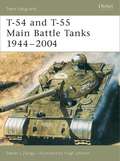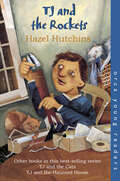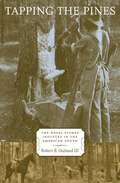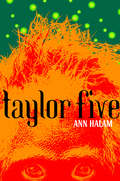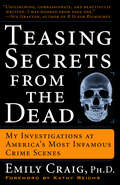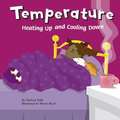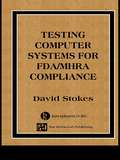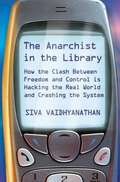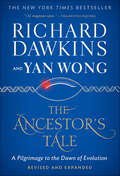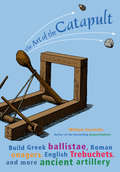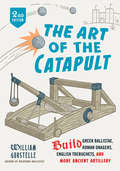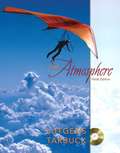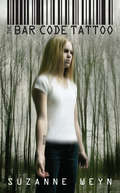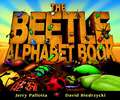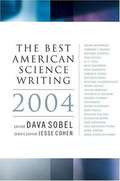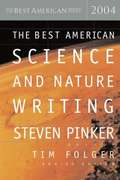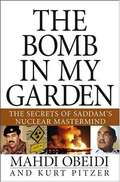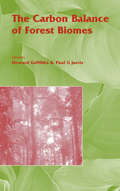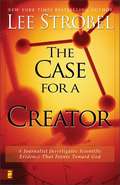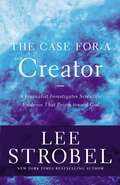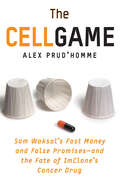- Table View
- List View
T-54 and T-55 Main Battle Tanks, 1944-2004
by Steven J. ZalogaThe T-54 and T-55 tanks are the most widely manufactured tanks of all time. They have become ubiquitous to wars around the globe since the 1950s, starting with Hungary in 1956, and including the the Arab-Israeli wars of 1967, 1973 and 1982, the Vietnam war of 1967-75, the Iran-Iraq War of 1980-88, the Afghanistan conflict, Operation Desert Storm, the Yugoslav Civil Wars, and the recent conflict in Iraq. This book will examine the roots of this prolific tank family, starting with the Soviet Army's first attempts to replace the legendary T-34 during World War II, and covering the T-43 and the T-44, the more successful T-54, and its ultimate evolution into the T-55.
THE DEVELOPMENT OF SCIENCE-BASED GUIDELINES FOR LABORATORY ANIMAL CARE: Proceedings of the November 2003 International Workshop
by Institute for Laboratory Animal ResearchInformation into THE DEVELOPMENT OF SCIENCE-BASED GUIDELINES FOR LABORATORY ANIMAL CARE
TJ and the Rockets (Orca Young Readers)
by Hazel HutchinsTJ overcame his fear of cats in TJ and the Cats and his fear of ghosts in TJ and the Haunted House. Now, he's not so keen on facing his fear of failure. His best friend Seymour is determined to come up with the latest greatest invention and TJ's gran expects TJ to build a rocket. The kittens, T-Rex and Alaska, are eager to get involved. When the first rocket that TJ builds plummets out of the sky, no parachute in sight, TJ is sure that his efforts are doomed. But are they?
Tapping the Pines: The Naval Stores Industry in the American South
by Robert B. Outland IIIThe extraction of raw turpentine and tar from the southern longleaf pine -- along with the manufacture of derivative products such as spirits of turpentine and rosin -- constitutes what was once the largest industry in North Carolina and one of the most important in the South: naval stores production. In a pathbreaking study that seamlessly weaves together business, environmental, labor, and social history, Robert B. Outland III offers the first complete account of this sizable though little-understood sector of the southern economy. Outland traces the South's naval stores industry from its colonial origins to the mid-twentieth century, when it was supplanted by the rising chemicals industry. A horror for workers and a scourge to the Southeast's pine forests, the methods and consequences of this expansive enterprise remained virtually unchanged for more than two centuries.An important part of the timber products trade, naval stores were originally used primarily in shipbuilding and maintenance. Over the course of the nineteenth century, these products came to be used in myriad ways -- including in the manufacture of paint thinner, soap, and a widely popular lamp oil -- and demand soared. In response, North Carolina producers enlarged their operations and expanded throughout the Southeast, especially into Georgia and Florida, but the short-term economic development they initiated ultimately contributed to long-term underdevelopment.Outland vividly describes the primitive harvest and production methods that eventually destroyed the very trees the trade relied upon, forcing operators to relocate every few years. He introduces the many different people involved in the industry, from the wealthy owner to the powerless worker, and explores the reliance on forced labor -- slavery before the Civil War and afterwards debt peonage and convict leasing. He demonstrates how the isolated forest environment created harsh working and living conditions, making the life of a turpentine hand and his family exceedingly difficult. With an exacting attention to detail and exhaustive research, Outland offers not only the first definitive history of the naval stores industry but also a fresh interpretation of the socioeconomic development of the piney woods South. Tapping the Pines is an essential volume for anyone interested in the region.
Taylor Five
by Ann HalamA gripping, deeply moving adventure raises startling questions about what it means to be human. Taylor Walker seems like any ordinary 14-year-old. Ordinary—if you overlook the fact that she lives on the island of Borneo, on a primate reserve run by her parents, and knows how to survive in the jungle. Obviously, Tay isn’t just like everyone else. But she is like one other person. She’s exactly like one other person. Tay is a clone, one of only five in the world, and her clone mother is Pam Taylor, a brilliant scientist.When rebels attack the reserve, Tay escapes with her younger brother and Uncle, an exceptionally intelligent orangutan. As they flee through the jungle, Tay must look within to find her strength: Pam’s DNA, tempered by Taylor’s extraordinary life. And she looks to Uncle for guidance—for Tay knows that the uncanny bond between Uncle and herself is the key to their survival.
Teasing Secrets from the Dead: My Investigations at America's Most Infamous Crime Scenes
by Emily CraigTeasing Secrets from the Dead is a front-lines story of crime scene investigation at some of the most infamous sites in recent history. In this absorbing, surprising, and undeniably compelling book, forensics expert Emily Craig tells her own story of a life spent teasing secrets from the dead. Emily Craig has been a witness to history, helping to seek justice for thousands of murder victims, both famous and unknown. It's a personal story that you won't soon forget. Emily first became intrigued by forensics work when, as a respected medical illustrator, she was called in by the local police to create a model of a murder victim's face. Her fascination with that case led to a dramatic midlife career change: She would go back to school to become a forensic anthropologist--and one of the most respected and best-known "bone hunters" in the nation. As a student working with the FBI in Waco, Emily helped uncover definitive proof that many of the Branch Davidians had been shot to death before the fire, including their leader, David Koresh, whose bullet-pierced skull she reconstructed with her own hands. Upon graduation, Emily landed a prestigious full-time job as forensic anthropologist for the Commonwealth of Kentucky, a state with an alarmingly high murder rate and thousands of square miles of rural backcountry, where bodies are dumped and discovered on a regular basis. But even with her work there, Emily has been regularly called to investigations across the country, including the site of the terrorist attack on the Murrah Building in Oklahoma City, where a mysterious body part--a dismembered leg--was found at the scene and did not match any of the known victims. Through careful scientific analysis, Emily was able to help identify the leg's owner, a pivotal piece of evidence that helped convict Timothy McVeigh. In September 2001, Emily received a phone call summoning her to New York City, where she directed the night-shift triage at the World Trade Center's body identification site, collaborating with forensics experts from all over the country to collect and identify the remains of September 11 victims. From the biggest news stories of our time to stranger-than-true local mysteries, these are unforgettable stories from the case files of Emily Craig's remarkable career.
Temperature: Heating Up and Cooling Down
by Darlene R. Stille Sheree BoydAn interesting book on temperature with its characteristics and facts illustrated with examples in the form of activities.
Termites (Nature's Children)
by Jen GreenDescribes the physical characteristics, habits, and habitats of termites.
Testing Computers Systems for FDA/MHRA Compliance
by David StokesThere is no substitute for extensive testing when it comes to IT systems. Recognition that problems are easier and cheaper to fix before the system is in use (rather than after), has turned testing into a cost-effective tool. However, when developing computer systems for pharmaceuticals manufacturing, testing to meet regulatory requirements adds an
The Anarchist in the Library: How the Clash Between Freedom and Control Is Hacking the Real World and Crashing the System
by Siva VaidhyanathanThis relatively brief book tackles an expansive topic: Internet technology and its effect on our social, political and cultural future. For cultural historian and media scholar Vaidhyanathan (Copyrights and Copywrongs), the digital revolution is about far more than downloading music. Weaving an array of historical examples with prescient analysis, Vaidhyanathan takes the Internet battles common to most readers today-e.g., the well-publicized efforts of the recording industry to stop file-sharing; the practices of those who share music online-to craft a treatise on how technology highlights the eternal cultural struggle between "oligarchy and anarchy."
The Ancestor's Tale: A Pilgrimage to the Dawn of Evolution
by Richard Dawkins Yan WongThe renowned biologist and thinker Richard Dawkins presents his most expansive work in this revised edition that offers a comprehensive look at evolution.Loosely based on the form of Chaucer's Canterbury Tales, Dawkins's tale takes us modern humans back through four billion years of life on our planet. As the pilgrimage progresses, we join with other organisms at the forty "rendezvous points" where we find a common ancestor. The band of pilgrims swells into a vast crowd as we join first with other primates, then with other mammals, and so on back to the first primordial organism.Dawkins's brilliant, inventive approach allows us to view the connections between ourselves and all other life in a bracingly novel way. It also lets him shed bright new light on the most compelling aspects of evolutionary history and theory: sexual selection, speciation, convergent evolution, extinction, genetics, plate tectonics, geographical dispersal, and more. The Ancestor's Tale is at once a far-reaching survey of the latest, best thinking on biology and a fascinating history of life on Earth. Here Dawkins shows us how remarkable we are, how astonishing our history, and how intimate our relationship with the rest of the living world.
The Art of Catapult: Build Greek Ballistae, Roman Onagers, English Trebuchets, and More Ancient Artillery
by William GurstelleWhether playing at defending their own castle or simply chucking pumpkins over a fence, wannabe marauders and tinkerers will become fast acquainted with Ludgar, the War Wolf, Ill Neighbor, Cabulus, and the Wild Donkey--ancient artillery devices known commonly as catapults. Building these simple yet sophisticated machines introduces fundamentals of math and physics using levers, force, torsion, tension, and traction. Instructions and diagrams illustrate how to build seven authentic working model catapults, including an early Greek ballista, a Roman onager, and the apex of catapult technology, the English trebuchet. Additional projects include learning how to lash and make rope and how to construct and use a hand sling and a staff sling. The colorful history of siege warfare is explored through the stories of Alexander the Great and his battle of Tyre; Saladin, Richard the Lionheart, and the Third Crusade; pirate-turned-soldier John Crabbe and his ship-mounted catapults; and Edward I of England and his battle against the Scots at Stirling Castle.
The Art of the Catapult: Build Greek Ballistae, Roman Onagers, English Trebuchets, And More Ancient Artillery
by William GurstelleCalling all pumpkin chuckers, wannabe marauders, and tinkerers of all ages! Flinging things and playing at defending your own castle has never been more fun. Whether playing at defending their own castle or simply chucking pumpkins over a fence, wannabe marauders and tinkerers will become fast acquainted with Ludgar the War Wolf, Ill Neighbor, Cabulus, and the Wild Donkey—ancient artillery devices known commonly as catapults. Updated and improved instructions and diagrams illustrate how to build 10 authentic working model catapults, including an early Greek ballista, a Roman onager, and the apex of catapult technology, the English trebuchet. Additional projects include learning how to lash and make rope and how to construct and use a hand sling and a staff sling. Building these simple yet sophisticated machines introduces fundamentals of math and physics using levers, force, torsion, tension, and traction. The colorful history of siege warfare is explored through the stories of Alexander the Great and his battle of Tyre; Saladin, Richard the Lionheart, and the Third Crusade; pirate-turned-soldier Jon Crabbe and his ship-mounted catapults; and Edward I of England and his battle against the Scots at Stirling Castle. For the legions of Tolkien fans, budding backyard warriors, and engineering wizards, this book is a must-have.
The Atmosphere: An Introduction to Meteorology (9th edition)
by Edward J. Tarbuck Frederick K. LutgensA standard textbook presenting a current and comprehensive survey of meteorology for undergraduates.
The Bar Code Tattoo (The Bar Code #1)
by Suzanne WeynIndividuality vs. conformity. Identity vs. access. Freedom vs. control.The bar code tattoo.The bar code tattoo. Everybody's getting it. It will make your life easier, they say. It will hook you in. It will become your identity. But what if you say no? What if you don't want to become a code? For Kayla, this one choice changes everything. She becomes an outcast in her high school. Dangerous things happen to her family. There's no option but to run . . . for her life.Indivuality vs. conformity.. Identity vs. access. Freedom vs. control.The bar code tattoo.
The Beetle Alphabet Book (Jerry Pallotta's Alphabet Books)
by Jerry PallottaLearn your beetles from A to Z as they crawl their way through the alphabet. Get to know the most diverse species on earth in this entertaining and informative nature ABC book. From the Dung Beetle to the Kalahari Beetle to the Zinc Metallic Beetles, the book is both fact-filled and fun for young readers. Full of Jerry Pallotta's signature humor and brought to life with bold artwork by award-winning illustrator, David Biedrzycki. A great introduction for the insect-enthused and lovers of all things that creep and crawl.
The Best American Science Writing 2004
by Dava Sobel Jesse CohenWhat makes the articles found in The Best American Science Writing 2004 "the best"? As Dava Sobel, best-selling author of Longitude and Galileo's Daughter, writes in her introduction, "First and most important, all are extremely well written. This sounds obvious, and it is, but for me it means the pieces impart genuine pleasure via the writers' choice of words and the rhythm of their phrases... 'I wish I'd written that,' was my own frequent reaction to the articles I ultimately chose." This year, Jennifer Kahn's "Stripped for Parts" was selected as the lead story because, as Sobel reveals, "it begins with one of the most arresting openings I have ever read. " In "Columbia's Last Flight," William Langewiesche recounts the February 1, 2003, space shuttle tragedy, along with the investigation into the nationwide complacency that brought the ship down. K. C. Cole's "Fun with Physics" is a profile of astrophysicist Janet Conrad that blends her personal life with professional activity. In "Desperate Measures," the doctor and writer Atul Gawande profiles the surgeon Francis Daniels Moore, whose experiments in the 1940s and '50s pushed medicine harder and farther than almost anyone had contemplated. Also included is a poem by the legendary John Updike, "Mars as Bright as Venus." The collection ends with Diane Ackerman's "ebullient" essay "We Are All a Part of Nature. " Together these twenty-three articles on a wide range of today's most current topics in science -- from biology, physics, biotechnology, and astronomy, to anthropology, genetics, evolutionary theory, and cognition -- represent the full spectrum of scientific writing from America's most prominent science authors, proving once again that "good science writing is evidently plentiful" ( Scientific American ).
The Best American Science and Nature Writing 2004
by Steven PinkerThe Best American Science and Nature Writing 2004, edited by Steven Pinker, is another "provocative and thoroughly enjoyable [collection] from start to finish" (Publishers Weekly). Here is the best and newest on science and nature.
The Bible Cure for High Cholesterol
by Don ColbertLower your cholesterol, and feel better naturally. Don't let a diagnosis of high cholesterol scare you. This easy-to-understand book uncovers a dynamically unique strategy for gaining control and living in vibrant, divine health--naturally. Reclaim God's very best for you, and get ready to win! You will: identify cholesterol-busting foods that can dramatically reduce your cholesterol levels; learn how powerful supplements can restore your health; discover what foods sabotage your cholesterol health. You want to be healthy. God wants you to be healthy. At last, here's a source of information that will help you live in health--body, mind and spirit.
The Bomb in My Garden: The Secrets of Saddam's Nuclear Mastermind
by Mahdi Obeidi Kurt PitzerObeidi, the former director-general of Iraq's Ministry of Industry and Military Industrialization under Saddam Hussein, was involved in Iraq's quest for a nuclear bomb beginning in the late 1970s. In this memoir, he tells his story of his work in the program, describing how the efforts came to a halt after the first Gulf War, and how he watched as the U. S. used allegations he knew were false to justify the invasion of his country. In many parts, the story is as much personal as professional as he worries about the fate of his family in difficult times.
The Carbon Balance of Forest Biomes: Vol 57 (Society for Experimental Biology)
by Howard Griffiths Paul G JarvisThe Carbon Balance of Forest Biomes provides an informed synthesis on the current status of forests and their future potential for carbon sequestration. This volume is timely, since convincing models which scale from local to regional carbon fluxes are needed to support these international agreements, whilst criticisms have been levelled at existing empirical approaches. One key question is to determine how well eddy-flux measurements at the stand-level represent regional-scale processes. This may be related to specific management practices (age, plantation, fertilisation) or simple bias in choosing representative sites (ease of access, roughness, proximity to physical barriers). The ecology and regeneration state of temperate, tropical and boreal forests under current climatic conditions are discussed, together with partitioning of photosynthetic and respiratory fluxes from soils and vegetation. The volume considers how to integrate contrasting methodologies, and the latest approaches for scaling from stand to the planetary boundary layer.
The Case for a Creator: A Journalist Investigates Scientific Evidence That Points Toward God
by Lee StrobelA Journalist Investigates Scientific Evidence That Points Toward God.
The Case for a Creator: A Journalist Investigates Scientific Evidence That Points Toward God (Case For ... Ser.)
by Lee StrobelMy road to atheism was paved by science . . . But, ironically, so was my later journey to God.” —Lee Strobel During his academic years, Lee Strobel became convinced that God was outmoded, a belief that colored his ensuing career as an award-winning journalist at the Chicago Tribune. Science had made the idea of a Creator irrelevant—or so Strobel thought. But today science is pointing in a different direction. In recent years, a diverse and impressive body of research has increasingly supported the conclusion that the universe was intelligently designed. At the same time, Darwinism has faltered in the face of concrete facts and hard reason. Has science discovered God? At the very least, it’s giving faith an immense boost as new findings emerge about the incredible complexity of our universe. Join Strobel as he reexamines the theories that once led him away from God. Through his compelling and highly readable account, you’ll encounter the mind-stretching discoveries from cosmology, cellular biology, DNA research, astronomy, physics, and human consciousness that present astonishing evidence in The Case for a Creator.
The Cell Game: Sam Waksal's Fast Money and False Promises—and the Fate of ImClone's Cancer Drug
by Alex Prud'hommeThe “chilling tale” of ImClone Systems, its promising cancer drug, Erbitux, and the insider trading scandal that ensnared Martha Stewart (U.S. News & World Report).The Cell Game is the quintessential business saga of the late 1990s. It's the story of big money and cutting-edge science, celebrity, greed, and slipshod business practices; the story of biotech hype and hope and every kind of excess.At the center of it all stands a single, enigmatic figure named Sam Waksal. A brilliant, mercurial, and desperate-to-be-liked entrepreneur, Waksal was addicted to the trappings of wealth and fame that accrued to a darling of the stock market and the overheated atmosphere of biotech IPOs. At the height of his stardom, Waksal hobnobbed with Martha Stewart in New York and Carl Icahn in the Hamptons, hosted parties at his fabulous art-filled loft, and was a fixture in the gossip columns. He promised that Erbitux would "change oncology," and would soon be making $1 billion a year.But as Waksal partied late into the night, desperate cancer patients languished, waiting for his drug to come to market. When the FDA withheld approval of Erbitux, the charming scientist who had always stayed just one step ahead of bankruptcy panicked and desperately tried to cash in his stock before the bad news hit Wall Street.Waksal served time in prison, the first of the Enron-era white-collar criminals to be sentenced. Yet his cancer drug has proved more durable than his evanescent profits.“A fast-paced, absorbing, and dramatic account . . . An important, excellent book that makes for fascinating reading.” —Library Journal
